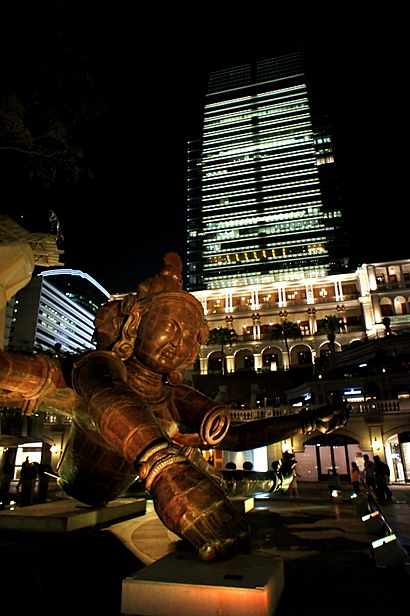Three Heads Six Arms facts for kids
Quick facts for kids Three Heads Six Arms |
|
|---|---|

The sculpture in Tsim Sha Tsui, Hong Kong (2011)
|
|
| Artist | Zhang Huan |
| Year | 2008 |
| Type | Sculpture |
| Medium |
|
| Location |
|
| Website | Official site: http://www.zhanghuan.com/worken/info_65.aspx?itemid=1054&parent&lcid=156 |
Three Heads Six Arms (Chinese: 三頭六臂; pinyin: Sān tóu liù bì) is a giant sculpture created by the famous Chinese artist Zhang Huan. This amazing artwork is made from copper and steel. It stands about 27 feet (8 meters) tall and weighs around 15 tons!
This huge sculpture has traveled to many places around the world. It was displayed in San Francisco, USA, from 2010 to 2011. After that, it moved to Hong Kong later in 2011. A slightly different version of the sculpture was even shown in Florence, Italy, in 2013. This copper sculpture is the biggest artwork Zhang Huan has made so far. Three Heads Six Arms is part of a larger collection of huge artworks by Zhang. These pieces are inspired by parts of ancient Buddhist statues, like arms, legs, and heads.
Contents
Creating the Giant Sculpture
Zhang Huan was inspired to create this series of sculptures by Buddhist art. He found broken pieces of old Buddhist statues in a market in Tibet. These pieces were left over from larger artworks that were damaged a long time ago. After moving to Shanghai, Zhang Huan started working on these sculptures.
Three Heads Six Arms was finished in 2008. It was the largest piece in this series at the time. The sculpture measures about 26 feet (8 meters) long, 59 feet (18 meters) wide, and 33 feet (10 meters) high.
How the Sculpture Was Built
Zhang Huan started by drawing sketches with ink. Then, his team made a smaller clay model, about 5 feet by 5 feet by 3 feet (150 x 150 x 90 cm). This clay model helped them build another model using steel and glass.
The copper workshop used the hands and body from the steel and glass model to create the huge copper sculpture. To move the sculpture, it can be taken apart into nine large pieces. It took a team of eight to ten people, a forklift, and a crane three days to put the sculpture together in San Francisco! Workers assemble the sculpture from the inside. The arms are used as exits until the very last arm is attached. There's even a secret trapdoor in one of the heads that allows technicians to leave the completed sculpture.
The Faces of the Sculpture
The sculpture has three faces. Two of these faces look like human features. One of them is even a self-portrait of the artist, Zhang Huan! The third face looks like a Buddha. The faces were made by adding clay over a steel frame. This clay and steel shape was then used to mold the hammered copper skin. After the copper skin was shaped, the pieces were welded together to form the heads.
Zhang Huan was inspired by a mix of Chinese folk stories and Tibetan Buddhist sculptures. He chose to leave the weld lines visible on purpose. He explained that for him, the copper pieces look like "stitched skin after an operation." This shows the journey and creation of the artwork.
Other Sculptures in the Series
Zhang Huan has made other sculptures that are similar to Three Heads Six Arms.
Smaller Version: Small Three Heads Six Arms
A smaller version called Small Three Heads Six Arms (Chinese: 小三頭六臂; pinyin: Xiǎo sān tóu liù bì) was completed in 2011. It measures about 4.4 feet (135 cm) tall, 8 feet (244 cm) wide, and 5 feet (156 cm) deep. This smaller sculpture was shown at the Storm King Art Center in New York in 2014.
The Six Paths of Transmigration
For an art festival in Taiwan in 2014, another similar copper and steel sculpture was displayed. It was called The Six Paths of Transmigration (Chinese: 六道轮回; pinyin: Liù dào lún huí). This sculpture also had multiple heads and arms. It was a bit smaller than the original Three Heads Six Arms sculpture.

